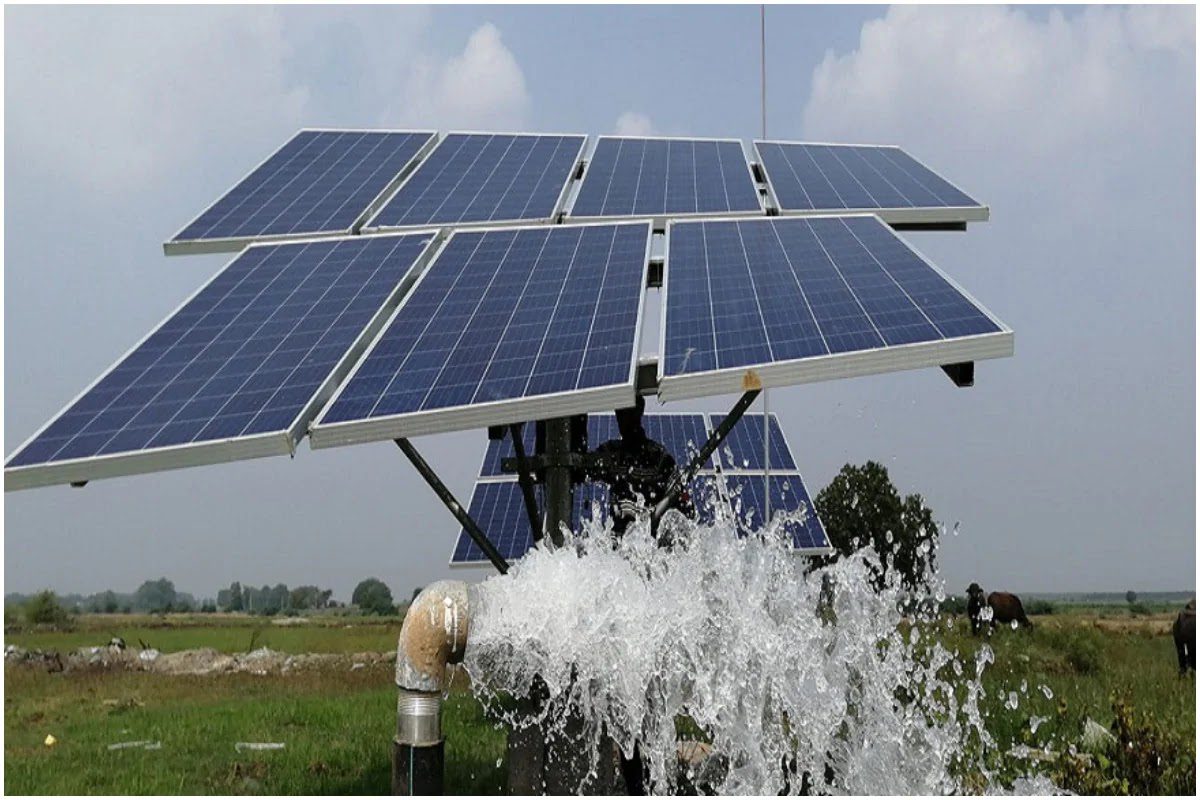Table of Contents
How to Get Solar Pump at a 60% Government Subsidy along with a 30% Government Loan!
The PM KUSUM Yojana 2023 also known as The Pradhan Mantri Kisan Urja Surekha Evam Utthaan Mahabhiyan plan, is a scheme by the Ministry of New and Renewable Energy ( MNRE), Government of India aimed at promoting the use of renewable energy and increasing the income of farmers. The scheme is a continuation of the previous version introduced on March 8, 2019, with amendments to suit the present situation.
The scheme encourages farmers to set up solar pumps for irrigation and provides a 60% government subsidy along with a 30% government loan for the installation of pump sets and tube wells. To promote carbon-free energy facilities around the country, this initiative was started. The form for registration of this is available on the government website.
The union government would give 3 crore solar pumps to farmers under Kusum Solar Yojana scheme up till 2023-24. This article aims to provide an extensive guide to the PM KUSUM Yojana, including its benefits, eligibility, and online registration process.
Objectives of PM KUSUM Yojana,
To promote the use of renewable energy sources in the agricultural sector:
The PM-KUSUM Yojana objective is to encourage farmers to shift from electric or diesel pumps to renewable energy sources, such as solar-powered pumps. This will help reduce the carbon footprint of the agricultural sector and contribute to India’s commitment to fighting against climate change.
To provide financial and technical support to farmers for installing solar pumps and other renewable energy-based technologies for irrigation:
The PM-KUSUM Yojana provides financial support to farmers to set up solar pumps for irrigation purposes, which will help reduce their dependence on traditional grid electricity and diesel-based pumps. The scheme also provides technical assistance to help farmers identify the most suitable and efficient renewable energy technologies for their needs.
To enhance the income of farmers by generating electricity through solar panels installed on their barren or uncultivable land:
The PM-KUSUM Yojana incentivizes farmers to install solar panels on their unproductive land and sell the electricity generated to the grid. This will help farmers earn additional income and contribute to the country’s renewable energy targets.
To reduce the dependency of farmers on traditional grid electricity, which is often unreliable and expensive:
The PM-KUSUM Yojana objective is to reduce the dependence of farmers on traditional grid electricity, which is often unreliable in rural areas and can be expensive. By promoting the use of renewable energy sources, such as solar power, the scheme aims to provide a more reliable and cost-effective source of electricity for farmers.
To promote decentralization of power generation and distribution in rural areas:
The PM-KUSUM Yojana Objective is to promote the decentralization of power generation and distribution in rural areas by encouraging the installation of small-scale renewable energy systems, such as solar pumps and panels. This will help increase access to electricity in remote areas and reduce the burden on the existing grid infrastructure.
To contribute to the achievement of the country’s renewable energy targets and reduce greenhouse gas emissions:
The PM-KUSUM Yojana Objective is to contribute to India’s target of achieving 175 GW of renewable energy capacity by 2022 and reduce the country’s greenhouse gas emissions. By promoting the use of renewable energy sources, the scheme will help India transition to a more sustainable and low-carbon economy.
PM KUSUM Yojana Amendments
The PM KUSUM Yojana underwent revisions recently to resolve the executive sanction problem faced by the “Pradhan Mantri Urja Suraksha evam utthan mahabyaan” program. Based on feedback from stakeholders, the yojana’s rules were amended.
The scheme’s three principal components remain in place through March 31, 2026. Also, there has been a transfer of funds from component B to the other components, and the execution of the scheme’s colour guidelines, elements, and components has been changed in connection with the expansion.
Benefits of PM KUSUM Yojana
The PM KUSUM Yojana provides numerous benefits for farmers, including:
- The government plans to provide farmers with a secure source of income and sustainable use of groundwater.
- This plan will also ensure uninterrupted access to electricity and reduce the carbon footprint of agriculture.
- Agricultural electricity subsidies will be reduced, easing the financial burden on farmers.
- Free power for irrigation will be provided, and farmers can generate extra electricity through solar power and sell it back to the grid for profit.
- Farmers will be able to utilize their unused land for solar power and earn a steady income for the next 25 years.
- This plan will enable farmers to utilize the power for agricultural purposes throughout the day.
Components of PM KUSUM Yojana
It consists of three components
Component A:
On unused land, laborers would construct 10,000 MW worth of decentralized, grid-connected renewable energy generating plants. Farmers, cooperatives, groups of farmers, panchayats, Water User Associations (WUA), and Farmer Producer Organizations (FPO) can assemble these networks within a 5 km radius of the sub-station.
Component B:
The scheme provides financial assistance to farmers for installing stand-alone solar agriculture pumps costing ₹17.50 lakh. With 7.5 HP of power, the new pumps can replace current diesel agriculture pumps.
Component C:
This component aims to solarize 10 lakh grid-connected farming pumps. Private farmlands with their grid-connected pumps will be provided with solar power under the scheme. At a set price, the Distribution Companies of India (DISCOMs) will buy surplus solar energy to meet the farmers’ irrigation needs.
Document Required for Application
- Aadhaar Card: Farmers must provide their Aadhaar card details as proof of identity.
- Land documents: Farmers must provide documents to prove that they own or lease the land where the solar pump will be installed. This could include land registration papers, lease agreements, or any other relevant documents.
- Bank account details: Farmers must provide their bank account details to receive the subsidy amount and loan disbursement.
- Electrical connection details: For grid-connected solar pumps, farmers must provide their electrical connection details, such as the connection type, connection load, and connection voltage.
- Quotation for solar pump installation: Farmers must provide a quotation for the installation of the solar pump from a registered vendor.
- NOC from local authorities: Farmers may also be required to obtain a No Objection Certificate (NOC) from the local authorities to install the solar pump.
- Any other relevant documents: The authorities may ask for any other relevant documents as deemed necessary.
Online Registration for PM KUSUM Yojana
Farmers can register online for the PM KUSUM Yojana on the official website of the Ministry of New and Renewable Energy. After registration, farmers can access information on the scheme’s guidelines, apply for financial assistance, and track their application status.
Visit PM Kisan Yojana’s official website

Login under PM Kisan Yojana

Fill out the loan interest application form

Check the beneficiary list

Check the test report

Related Posts







